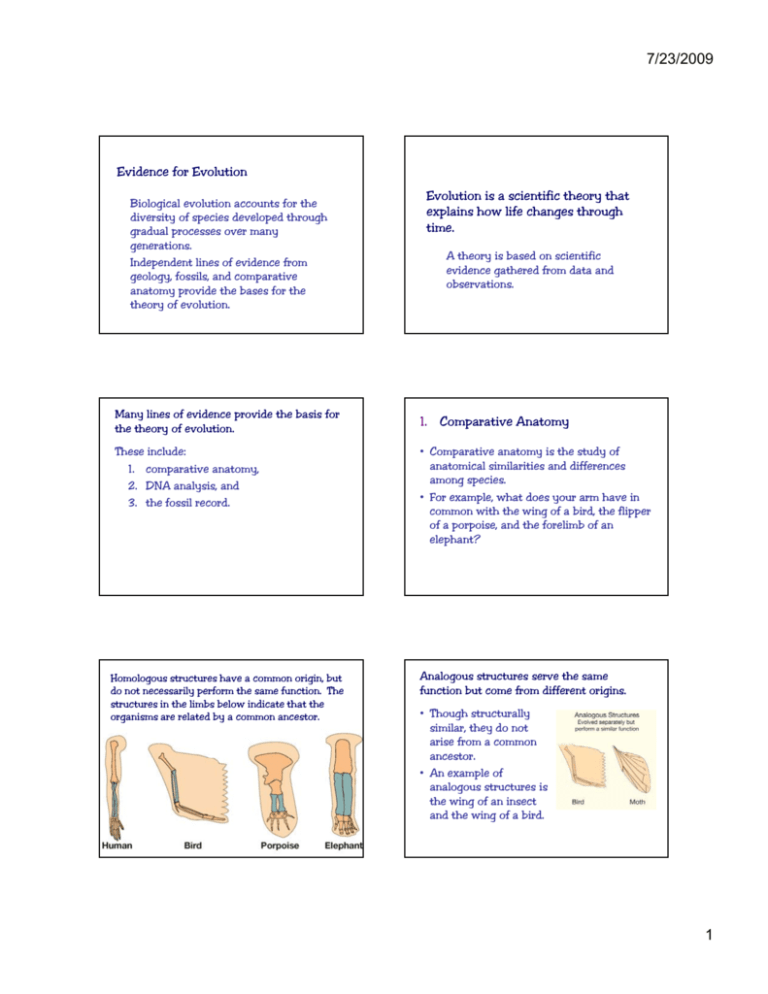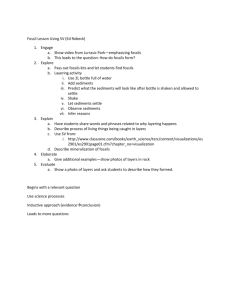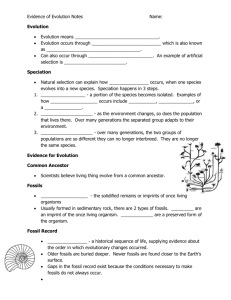Evidence for Evolution
advertisement

7/23/2009 Evidence for Evolution Biological evolution accounts for the diversity of species developed through gradual processes over many generations. Independent lines of evidence from geology, fossils, and comparative anatomy provide the bases for the theory of evolution. Many lines of evidence provide the basis for the theory of evolution. These include: 1. comparative anatomy, 2. DNA analysis, and 3. the fossil record. Homologous structures have a common origin, but do not necessarily perform the same function. The structures in the limbs below indicate that the organisms are related by a common ancestor. Evolution is a scientific theory that explains how life changes through time. A theory is based on scientific evidence gathered from data and observations. 1. Comparative Anatomy • Comparative anatomy is the study of anatomical similarities and differences among species. • For example, example what does your arm have in common with the wing of a bird, the flipper of a porpoise, and the forelimb of an elephant? Analogous structures serve the same function but come from different origins. • Though structurally similar, they do not arise from a common ancestor. • An example of analogous structures is the wing of an insect and the wing of a bird. 1 7/23/2009 Another way to compare the anatomy of different species is to compare their embryos. • Comparative anatomists have discovered similarities in embryos of vertebrates. 2. All species of organisms have DNA as their hereditary material. • Scientists compare the DNA base sequences of different species to determine evolutionary relationships. • Species that share more similarities in their DNA base sequences are more closely related than those that share fewer similarities. • Scientists hypothesize that if two species have similarities in their base sequences, they share a common ancestor. Comparing human DNA to other organisms Vertebrates are animals with a backbone. • You are a vertebrate. So are other mammals, birds, reptiles, and fish. • Adult vertebrates also share many similarities in their skeletons and muscles. muscles • This is evidence that all vertebrates descended from a common ancestor. The diagram on the next slide compares the DNA base sequences in the gene that codes for hemoglobin in vertebrates. • The greater the number of differences in base sequences sequences, the farther the evolutionary distance from humans. 3. Much of the evidence for evolution comes from studying fossils. • A fossil is a remnant or trace of an organism from the past, such as a skeleton or leaf imprint, embedded and preserved in Earth’s crust. 2 7/23/2009 Earth’s crust is its outermost layer made mostly of rock. • Most fossils are dug up from sedimentary rock layers. • Sedimentary rock is rock that has formed from sediments, like sand, mud, or small pieces of rock. Over long periods of time, sediments are squeezed together as they are buried under more and more layers that pile up. • Eventually, those sediments are compressed into sedimentary rock. • The layers that are farther down in Earth’s crust are older than the upper layers. How fossils are formed. The body parts that do not rot are buried under layers of sediments. • Many fossils are formed from the hard parts of an organism’s body like bones and teeth. • Fossil formation begins g when an organism’s body is quickly covered in sediments from an event like a mudslide or a sand storm. • Over time, more and more sediments cover the remains. • After a long time, the chemicals in the body parts are replaced with rockrock like minerals. • This process results in a heavy, rock-like copy of the original object—a fossil. Fossils provide a historical sequence of life on Earth known as the fossil record. Although scientists have collected thousands of fossils, there are many gaps in the fossil record. • Fossils found in the upper (newer) sedimentary layers more closely resemble present-day organisms than fossils found in deeper (older) layers. • That is because most ancient species did not fossilize. They simply decayed and were lost from the fossil record. • Scientists estimate that only a small percentage of past organisms have been (or will be) found as fossils. 3 7/23/2009 Video Clip from PBS – How do we know Evolution Happens http://www.pbs.org/wgbh/evolution/library/11/2/quicktime/e_s_3.html 4






